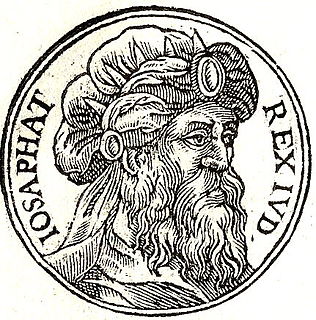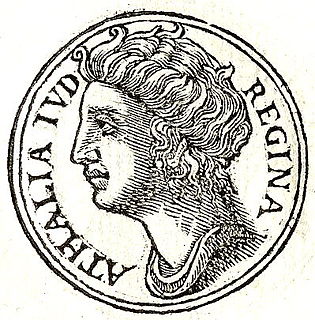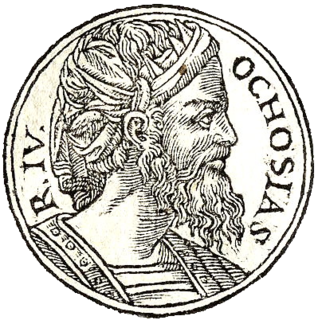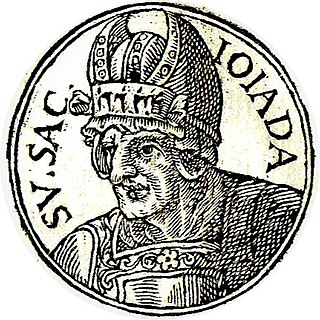
Jehoshaphat,(; alternatively spelled Jehosaphat, Josaphat, or Yehoshafat; Hebrew: יְהוֹשָׁפָט, Modern: Yəhōšafat, Tiberian: Yehōšāp̄āṭ, "Jehovah has judged"; Greek: Ἰωσαφάτ, romanized: Iosafát; Latin: Josaphat) according to 1 Kings 15:24, was the son of Asa, and the king of the Kingdom of Judah, in succession to his father. His children included Jehoram, who succeeded him as king. His mother was Azubah. Historically, his name has sometimes been connected with the Valley of Josaphat.

Jehu was the tenth king of the northern Kingdom of Israel since Jeroboam I, noted for exterminating the house of Ahab. He was the son of Jehoshaphat, grandson of Nimshi, and possibly great-grandson of Omri. His reign lasted for 28 years.

The Kingdom of Judah was an Iron Age kingdom of the Southern Levant. The Hebrew Bible depicts it as the successor to the United Monarchy, a term denoting the Kingdom of Israel under biblical kings Saul, David and Solomon and covering the territory of two historical kingdoms, Judah and Israel; but some scholars, including Finkelstein and Alexander Fantalkin, believe that the existent archaeological evidence for an extensive Kingdom of Judah before the late 8th century BCE is too weak, and that the methodology used to obtain the evidence is flawed. Such scholars believe that, prior to this era, the kingdom was no more than a small tribal entity which was limited to Jerusalem and its immediate surroundings.

According to the Hebrew Bible, the Kingdom of Israel was one of two successor states to the former United Kingdom of Israel and Judah. Historians often refer to the Kingdom of Israel as the "Northern Kingdom" or as the "Kingdom of Samaria" to differentiate it from the Southern Kingdom of Judah.

Athaliah was queen consort of Judah as the wife of King Jehoram, a descendant of King David, and later queen regnant c. 841–835 BC.

Jehoram was a king of the northern Kingdom of Israel. He was the son of Ahab and Jezebel, and brother to Ahaziah and Athaliah.

Jehoram of Judah or Joram, was a king of Judah, and the son of Jehoshaphat. Jehoram took the throne at the age of 32 and reigned for 8 years.

Ahaziah of Judah or Jehoahaz, was a king of Judah, and the son of Jehoram and Athaliah, the daughter of king Ahab of Israel. He was also the first Judahite king to be descended from both the House of David and the House of Omri, through his mother and successor, Athaliah.
Jehoahaz or Joachaz was the name of several people mentioned in the Hebrew Bible.

The Black Obelisk of Shalmaneser III is a black limestone Assyrian sculpture with many scenes in bas-relief and inscriptions. It comes from Nimrud, in northern Iraq, and commemorates the deeds of King Shalmaneser III. It is on display at the British Museum in London, and several other museums have cast replicas.

The Kings of Judah were the monarchs who ruled over the ancient Kingdom of Judah. According to the biblical account, this kingdom was founded after the death of Saul, when the tribe of Judah elevated David to rule over it. After seven years, David became king of a reunited Kingdom of Israel. However, in about 930 BCE the united kingdom split, with ten of the twelve Tribes of Israel rejecting Solomon's son Rehoboam as their king. The tribes of Judah and Benjamin remained loyal to Rehoboam, and re-formed the Kingdom of Judah, while the other entity continued to be called the Kingdom of Israel, or just Israel.

Matthew 1:8 is the eighth verse of the first chapter of the Gospel of Matthew in the New Testament. The verse is part of the section where the genealogy of Joseph, the legal father of Jesus, is listed.
Libnah or Lobna was an independent city, probably near the western seaboard of Israel, with its own king at the time of the Israelite occupation of Canaan. It is thought to have been an important producer of revenue, and one that rebelled against the Judahite crown. It is assigned to the tribe of Judah as one of the 13 Kohanic cities during the Israelite settlement. The town revolted during the reign of King Jehoram of Judah, according to 2 Kings 8:22 and 2 Chronicles 21:10, because Jehoram "had abandoned [the] God of his fathers". The revolt took place at the same time as Edom revolted against Judean rule.

Jehoiada in the Hebrew Bible, was a prominent priest during the reigns of Ahaziah (reigned c. 842 - 841 BCE), Athaliah, and Joash(reigned c. 836–796 BC). Jehoiada became the brother-in-law of King Ahaziah as a result of his marriage with princess Jehosheba. Both Jehosheba and Ahaziah were children of King Jehoram of Judah. Ahaziah died a year after assuming the throne, which was then usurped by his mother Athaliah, who ordered the execution of all members of the royal family.
The Omrides, Omrids or House of Omri were a ruling dynasty of the Kingdom of Israel (Samaria) founded by King Omri. According to the Bible, the Omride rulers of Israel were Omri, Ahab and Ahab's sons Ahaziah and Jehoram. Ahab's daughter Athaliah also became queen regnant of the Kingdom of Judah.
Jehosheba, or Josaba, is a figure in the Hebrew Bible. She was the daughter of King Jehoram of Judah, sister to King Ahaziah of Judah and wife of Jehoiada the priest. She was a daughter of Jehoram, but not necessarily of Athaliah. After the death of Ahaziah, his mother, Athaliah, made herself Queen of Judah and ordered the execution of all members of the royal family that could claim the throne. However, according to 2 Kings 11:2, Jehosheba saved from the massacre her infant nephew Jehoash, Ahaziah's son and Athaliah's grandson:
But Jehosheba, the daughter of king Joram, sister of Ahaziah, took Joash the son of Ahaziah, and stole him from among the king's sons which were slain; and they hid him, even him and his nurse, in the bedchamber from Athaliah, so that he was not slain.
Nimshi is a character in the Hebrew Bible. He is mentioned in the Books of Kings and the Second Book of Chronicles as father, grandfather, or possibly a forebear of Jehu, the king of the Northern Kingdom of Israel.

This article is an overview of the kings of the United Kingdom of Israel as well as those of its successor states and classical period kingdoms ruled by the Hasmonean dynasty and Herodian dynasty.
The House of Jehu or Jehu dynasty was a reigning dynasty of the Kingdom of Israel. They are depicted in both of the Books of Kings. Their estimated reign is placed from the 9th century to the 8th century BCE.











